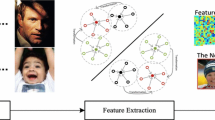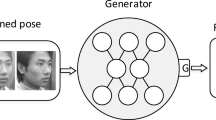Abstract
Face recognition under variable pose and illumination is a challenging problem in computer vision tasks. In this paper, we solve this problem by proposing a new residual based deep face reconstruction neural network to extract discriminative pose-and-illumination-invariant (PII) features. Our deep model can change arbitrary pose and illumination face images to the frontal view with standard illumination. We propose a new triplet-loss training method instead of Euclidean loss to optimize our model, which has two advantages: a) The training triplets can be easily augmented by freely choosing combinations of labeled face images, in this way, overfitting can be avoided; b) The triplet-loss training makes the PII features more discriminative even when training samples have similar appearance. By using our PII features, we achieve 83.8% average recognition accuracy on MultiPIE face dataset which is competitive to the state-of-the-art face recognition methods.






Similar content being viewed by others
References
Ahonen T, Hadid A, Pietikainen M (2006) Face description with local binary patterns: application to face recognition. IEEE Trans Pattern Anal Mach Intell 28:2037–2041
Asthana A, Marks TK, Jones MJ, Tieu KH, Rohith M (2011) Fully automatic pose-invariant face recognition via 3d pose normalization. In: International conference on computer vision (ICCV), IEEE
Belhumeur P, Hespanha J, Kriegman D (1997) Eigenfaces vs. fisherfaces: recognition using class specific linear projection. IEEE Trans Pattern Anal Mach Intell 19(7):711–720
Castillo CD, Jacobs DW (2011) Wide-baseline stereo for face recognition with large pose variation. In: Conference on computer vision and pattern recognition (CVPR), IEEE
Chen D, Cao X, Wen F, Sun J (2013) Blessing of dimensionality: high-dimensional feature and its efficient compression for face verification. In: Conference on computer vision and pattern recognition (CVPR), IEEE
Gross R, Matthews I, Cohn J, Kanade T, Baker S (2008) Multi-pie. In: International Conference on Automatic Face and Gesture Recognition
He K, Zhang X, Ren S, Sun J (2016) Deep residual learning for image recognition. In: Conference on computer vision and pattern recognition (CVPR), IEEE
Huang G B, Lee H, Learned-Miller E (2012) Learning hierarchical representations for face verification with convolutional deep belief networks. In: Conference on computer vision and pattern recognition (CVPR), IEEE
Ioffe S, Szegedy C (2015) Batch normalization: accelerating deep network training by reducing internal covariate shift. In: International conference on Machine learning (ICML)
Jia Y, Shelhamer E, Donahue J, Karayev S, Long J, Girshick R, Darrell T (2014) Caffe: convolutional architecture for fast feature embedding. In: International conference on multimedia. ACM, 2014
Kan M, Shan S, Chang H, Chen X (2014) Stacked progressive auto-encoders (spae) for face recognition across poses. In: Conference on computer vision and pattern recognition (CVPR), IEEE
Krizhevsky A, Sutskever I, Hinton G (2012) Imagenet classification with deep convolutional neural networks. In: Advances in neural information processing systems (NIPS)
Li S, Liu X, Chai X, Zhang H, Lao S, Shan S (2012) Morphable displacement field based image matching for face recognition across pose. In: European conference on computer vision (ECCV), Springer
Li A, Shan S, Gao W (2012) Coupled bias–variance tradeoff for cross-pose face recognition. IEEE Trans Image Process 21(1):305–315
Liu C, Wechsler H (2002) Gabor feature based classification using the enhanced fisher linear discriminant model for face recognition. Trans Image Process 11:467–476
Long J, Shelhamer E, Darrell T (2015) Fully convolutional networks for semantic segmentation. In: Conference on computer vision and pattern recognition (CVPR), IEEE
Lowe DG (2004) Distinctive image features from scale-invariant keypoints. Int J Comput Vis 60:91–110
Maaten LVD, Hinton G (2008) Visualizing data using t-sne. J Mach Learn Res 9(2579–2605):85
Mathias M., Benenson R., Pedersoli M., Van Gool L (2014) Face detection without bells and whistles. In: European conference on computer vision (ECCV), Springer
Parkhi OM, Vedaldi A, Zisserman A (2015) Deep face recognition. In: British Machine Vision Conference (BMVC)
Schroff F, Treibitz T, Kriegman D, Belongie S (2011) Pose, illumination and expression invariant pairwise face-similarity measure via doppelg¨anger list comparison. In: International conference on computer vision (ICCV), IEEE
Schroff F, Kalenichenko D, Philbin J (2015) Facenet: a unified embedding for face recognition and clustering. In Conference on computer vision and pattern recognition (CVPR), IEEE
Simonyan K, Zisserman A (2014) Very deep convolutional networks for large-scale image recognition. arXiv preprint arXiv:1409.1556
Simonyan K, Zisserman A (2015) Very deep convolutional networks for large-scale image recognition. In: International Conference on Learning Representations
Srivastava N, Hinton GE, Krizhevsky A, Sutskever I, Salakhutdinov R (2014) Dropout: a simple way to prevent neural networks from overfitting. J Mach Learn Res 15(1):1929–1958
Sun Y, Wang X, Tang X (2013) Deep convolutional network cascade for facial point detection. In: Conference on computer vision and pattern recognition (CVPR), IEEE
Sun Y, Wang X, Tang X (2014) Deep learning face representation from predicting 10, 000 classes. In Conference on computer vision and pattern recognition (CVPR), IEEE
Sun Y, Wang X, Tang X (2015) Deeply learned face representations are sparse, selective, and robust. In: Conference on computer vision and pattern recognition (CVPR), IEEE
Szegedy C, Liu W, Jia Y, Sermanet P, Reed S, Anguelov D, Erhan D, Vanhoucke V, Rabinovich A (2015) Going deeper with convolutions. In: Conference on computer vision and pattern recognition (CVPR), IEEE
Taigman Y, Yang M, Ranzato MA, Wolf L (2014) Deep-face: closing the gap to human-level performance in face verification. In: Conference on computer vision and pattern recognition (CVPR), IEEE
Taigman Y, Yang M, Ranzato MA, Wolf L (2015) Web-scale training for face identification. In: Conference on computer vision and pattern recognition (CVPR), IEEE
Tang X, Wang X (2004) Face sketch recognition. IEEE Trans Circuits and Syst Video Technol 14(1):50–57
Wen Y, Zhang K, Li Z, Qiao Yu (2016) A discriminative feature learning approach for deep face recognition. In: European conference on computer vision (ECCV), Springer
Yim J, Jung H, Yoo B, Choi C, Park D, Kim J (2015) Rotating your face using multi-task deep neural network. In: conference on computer vision and pattern recognition (CVPR), IEEE
Zhang W, Wang X, Tang X (2011) Coupled information-theoretic encoding for face photo-sketch recognition. In: conference on computer vision and pattern recognition (CVPR), IEEE
Zhu Z, Luo P, Wang X, and Tang X (2013) Deep learning identity-preserving face space. In: International conference on computer vision (ICCV), IEEE
Zhu Z, Luo P, Wang X, Tang X (2014) Multi-view perceptron: a deep model for learning face identity and view representations. In: Advances in neural information processing systems (NIPS)
Acknowledgements
This work was supported in part by the National Key Research and Development Program of China under grant No.2016YFB1000903, and NSFC No.61573268.
Author information
Authors and Affiliations
Corresponding authors
Rights and permissions
About this article
Cite this article
Chen, X., Lan, X., Liang, G. et al. Pose-and-illumination-invariant face representation via a triplet-loss trained deep reconstruction model. Multimed Tools Appl 76, 22043–22058 (2017). https://doi.org/10.1007/s11042-017-4782-y
Received:
Revised:
Accepted:
Published:
Issue Date:
DOI: https://doi.org/10.1007/s11042-017-4782-y




